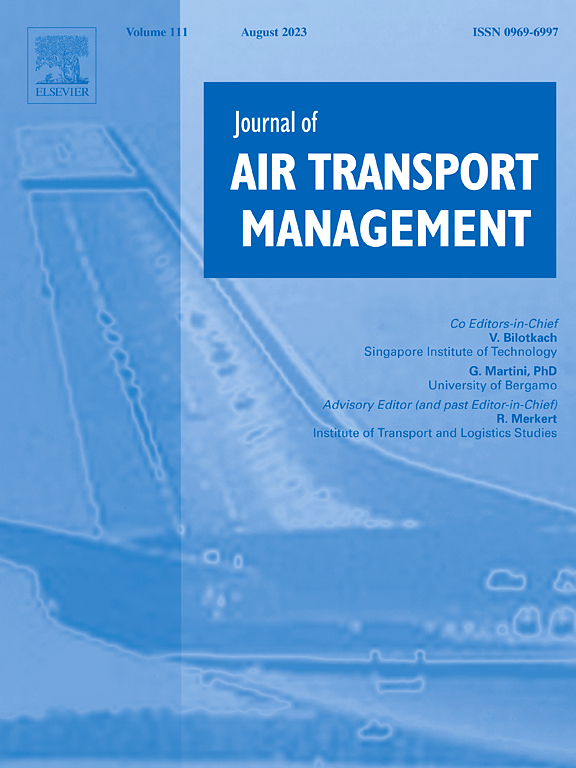Data-driven recognition of hot taxiway segments for assessing airport surface traffic efficiency
IF 3.6
2区 工程技术
Q2 TRANSPORTATION
引用次数: 0
Abstract
Due to the continuous growth in air transportation demand, the complexity of airport surface traffic systems, and the variability in aircraft behavior, airport surface traffic exhibits serious spatial heterogeneity. This complexity not only heightens the likelihood of surface conflicts and unsafe events, but also has a substantial impact on both the operational efficiency and safety of airport operations. Current research on airport surface hotspots mainly focuses on conflict hotspots and risk hotspots, and fewer studies are conducted on busy hotspots. In order to fill this research gap, this paper proposes an accurate matching method of airport surface trajectory and taxiway system based on Hidden Markov Algorithm. And establishes an indicator system to characterize airport surface taxiway, which is used to comprehensively reflect the airport surface taxiway operation efficiency. On this basis, an Airport Surface Hot-Taxiway-Segment Recognition Model (ASHRM) is proposed which innovatively introduces the new concept of hot index to quantify and measure the popularity of taxiway segments, thus realizing the recognition of hot taxiway segments. Through the experimental analysis of real data from SZX Airport, the results show that the recognized hot taxiway segments are consistent with actual airport operations, and the cumulative traffic flow is identified as the most critical factor affecting the formation of hot taxiway segments. This method not only provides a scientific basis for the operational management and efficiency assessment of airports, but also realizes the scientific recognition of hot taxiway segments in the dynamically changing airport surface transportation systems.
热滑行道路段的数据驱动识别用于评估机场地面交通效率
由于航空运输需求的持续增长、机场地面交通系统的复杂性以及飞机行为的可变性,机场地面交通呈现出严重的空间异质性。这种复杂性不仅增加了发生地面冲突和不安全事件的可能性,而且对机场运营的效率和安全都产生了重大影响。目前对机场地面热点的研究主要集中在冲突热点和风险热点,对繁忙热点的研究较少。为了填补这一研究空白,本文提出了一种基于隐马尔可夫算法的机场地面轨迹与滑行道系统的精确匹配方法。并建立了表征机场地面滑行道的指标体系,用以综合反映机场地面滑行道的运行效率。在此基础上,提出了机场地面热滑行道段识别模型(ASHRM),该模型创新性地引入热指数的概念,量化和衡量滑行道段的受欢迎程度,从而实现了热滑行道段的识别。通过对SZX机场实际数据的实验分析,结果表明,识别出的热滑行道路段与机场实际运行情况一致,并确定累积交通流量是影响热滑行道路段形成的最关键因素。该方法不仅为机场的运行管理和效率评价提供了科学依据,而且实现了在动态变化的机场地面运输系统中对热滑行道段的科学识别。
本文章由计算机程序翻译,如有差异,请以英文原文为准。
求助全文
约1分钟内获得全文
求助全文
来源期刊

Journal of Air Transport Management
TRANSPORTATION-
CiteScore
12.40
自引率
11.70%
发文量
97
期刊介绍:
The Journal of Air Transport Management (JATM) sets out to address, through high quality research articles and authoritative commentary, the major economic, management and policy issues facing the air transport industry today. It offers practitioners and academics an international and dynamic forum for analysis and discussion of these issues, linking research and practice and stimulating interaction between the two. The refereed papers in the journal cover all the major sectors of the industry (airlines, airports, air traffic management) as well as related areas such as tourism management and logistics. Papers are blind reviewed, normally by two referees, chosen for their specialist knowledge. The journal provides independent, original and rigorous analysis in the areas of: • Policy, regulation and law • Strategy • Operations • Marketing • Economics and finance • Sustainability
 求助内容:
求助内容: 应助结果提醒方式:
应助结果提醒方式:


